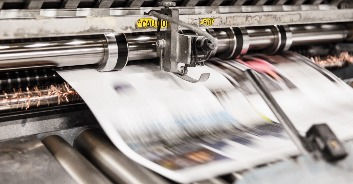Change of Pace: 6 ways the print industry has changed in the last 60 years
- Marcus Bowen
- Jun 20, 2022
- 2 min read
This is the final instalment of our look back at the changes that have had the biggest impact in the print industry over the 6 decades that LG Davis has been in operation. We have looked at everything from gender roles to technology to sustainability, and in this last section Liz Smith discusses the pace of the industry and how everything has sped up.

“When we first started it wouldn’t be unheard of for print runs to take days with lead times of several weeks. Now we are seeing everything needed instantly. The rise in digital printing has revolutionised the speed at which print is produced. We print thousands of sheets a minute and orders are taken, turned around and delivered in hours not days or weeks.”
Letterpress printing, was a slow and laborious task but 60 years ago it was our only method of printing. Each colour had to be printed separately and drying time allowed in between to prevent the ink smudging. This meant

there was an understanding that print couldn’t be rushed, and businesses planned jobs weeks, sometimes months in advance.
Now resigned to an artisan craft the slow pace of letterpress printing has completely changed with the process of
printing itself drastically sped up thanks to a boom in technological advancements and in response so has customer expectation.
With the rise of lithographical and then digital printing in the 1990s there is scope to offer so much more creativity, personalisation, finishing techniques and special details that would just have been impossible before.

Booklets can be printed, collated, stitched and trimmed inline. Leaflets and brochures can be mass produced each one having bespoke details, with multiple designs and colours printed simultaneously. Technology has changed our ways of working and customer’s expectations.
It is not unheard of for printers to turn print runs round the next day and for jobs to take merely hours from start to finish.
“To create bespoke letterheads or invoices for a customer when Dad first started the business meant each letter would be changed by hand to produce the new document, before printing. It really is awe inspiring to see how far the industry has come over the past 6 decades, and I am sure it will continue into our next decade.”
Want to find out more? Take a look back over our series and explore all the ways that print has drastically changed in just 60 years. From reduced costs, advances in technology, changing faces, home printing and greener focuses there have been many changes over the past six decades which have shaped the industry and LG Davis has been proud to have been a part of every one of them.








































Comments